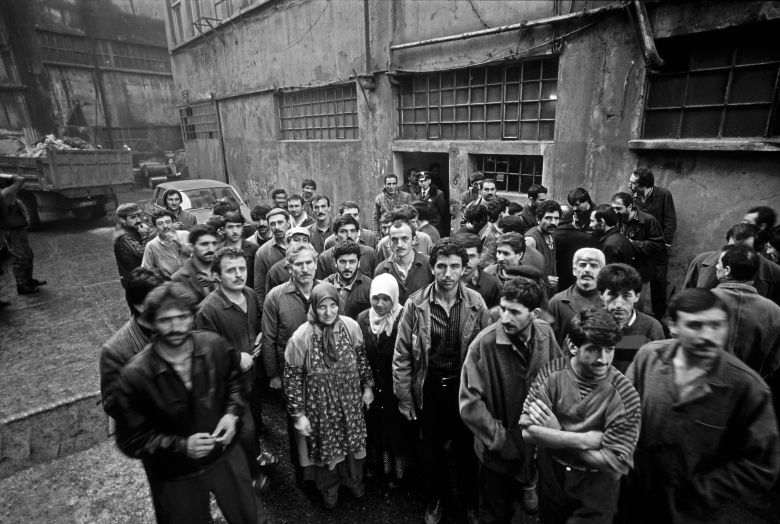Salt Research
Ali Öz Archive

Leatherworkers’ strike in Kazlıçeşme, Istanbul, 1987
Salt Research, Ali Öz Archive
Salt Research, Ali Öz Archive
Photographer and photojournalist Ali Öz’s archive can now be accessed at archives.saltresearch.org.
The collection comprises nearly 5,000 photographs documenting the social and spatial transformation of Türkiye from 1978 to the early 2000s. The black-and-white images, often focused on people, capture the struggles of the working class—from women working in the highlands of the Black Sea and nomads raising livestock in the Taurus Mountains to miners in Zonguldak, fishermen in İzmir, cotton farmers in Adana, and child laborers on construction sites in Istanbul. The archive also includes photographs from the demolition of slums in Istanbul and the changing landscape of Beyoğlu during the construction of Tarlabaşı Boulevard in the 1980s. Portraying both individual stories and social changes shaping collective memory across a wide geographic scope, these photographs serve as an important visual record of Türkiye’s sociocultural and urban fabric.
About Ali Öz
Born in 1954, Ali Öz graduated from the Department of Radio and Television at Ankara University’s Faculty of Political Sciences in 1982. He began taking photographs in 1978 with a camera he acquired on a limited budget. In his youth, he worked in the field of social politics before turning to press photography. Adopting a style that can be described as “political documentary,” Öz aimed to use his camera to capture social protests on issues affecting people in Türkiye and around the world. Throughout his career, he has worked for various publications, including Nokta, Güneş, Milliyet, Cumhuriyet, Aktüel, Tempo, NTV MAG, and Birgün. He continues to work as a freelance photojournalist.
Salt Research City, Society, and Economy Archive
The archive collections at Salt Research encompass over 2,000,000 unique digitized resources on “Art,” “Architecture and Design,” and “City, Society, and Economy.” Comprising documents related to education, social life, and the built environment from the 19th century to the present, the visual materials in the City, Society, and Economy Archive include printed photographs, glass negatives and positives, slides, film negatives, postcards, and photocards.
The collection comprises nearly 5,000 photographs documenting the social and spatial transformation of Türkiye from 1978 to the early 2000s. The black-and-white images, often focused on people, capture the struggles of the working class—from women working in the highlands of the Black Sea and nomads raising livestock in the Taurus Mountains to miners in Zonguldak, fishermen in İzmir, cotton farmers in Adana, and child laborers on construction sites in Istanbul. The archive also includes photographs from the demolition of slums in Istanbul and the changing landscape of Beyoğlu during the construction of Tarlabaşı Boulevard in the 1980s. Portraying both individual stories and social changes shaping collective memory across a wide geographic scope, these photographs serve as an important visual record of Türkiye’s sociocultural and urban fabric.
About Ali Öz
Born in 1954, Ali Öz graduated from the Department of Radio and Television at Ankara University’s Faculty of Political Sciences in 1982. He began taking photographs in 1978 with a camera he acquired on a limited budget. In his youth, he worked in the field of social politics before turning to press photography. Adopting a style that can be described as “political documentary,” Öz aimed to use his camera to capture social protests on issues affecting people in Türkiye and around the world. Throughout his career, he has worked for various publications, including Nokta, Güneş, Milliyet, Cumhuriyet, Aktüel, Tempo, NTV MAG, and Birgün. He continues to work as a freelance photojournalist.
Salt Research City, Society, and Economy Archive
The archive collections at Salt Research encompass over 2,000,000 unique digitized resources on “Art,” “Architecture and Design,” and “City, Society, and Economy.” Comprising documents related to education, social life, and the built environment from the 19th century to the present, the visual materials in the City, Society, and Economy Archive include printed photographs, glass negatives and positives, slides, film negatives, postcards, and photocards.

